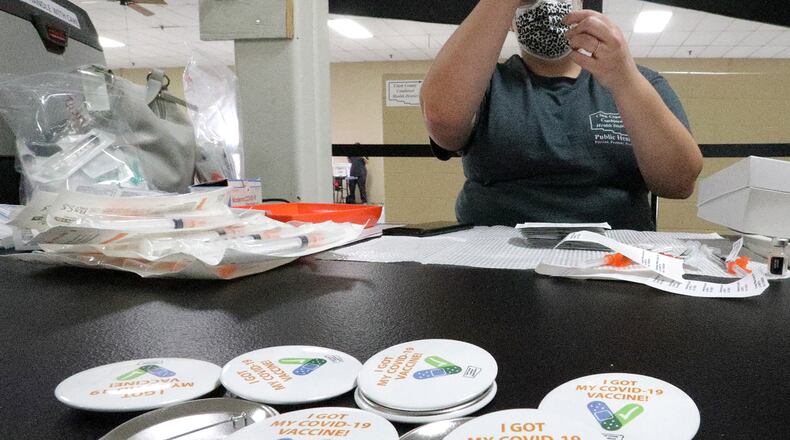“We’re really looking for this to become a trend,” Clark County Combined Health District health commissioner Charles Patterson said. “That’s the thing we really want to look for: can we continue to see that come down week after week.”
Patterson updated the community about the state of COVID-19 in the county during his weekly livestream.
Patterson said the “curve” of cases is appearing to level off, but the county’s health district won’t know for a few weeks if the area is “leveling off.”
Patterson also discussed booster doses for COVID-19 during his livestream.
Booster doses were approved on Wednesday by the Food and Drug Administration for the Pfizer vaccine for a pool of people, according to a joint news release Friday from public health agencies in Champaign, Clark, Darke, Greene, Miami, Montgomery, Preble, Shelby). Eligible people are the following:
- People 65 years and older and residents in long-term care settings should receive a booster shot of Pfizer-BioNTech’s COVID-19 vaccine at least 6 months after their Pfizer-BioNTech primary series.
- People ages 50 to 64 with certain underlying medical conditions should receive a booster shot of Pfizer-BioNTech’s COVID-19 vaccine at least 6 months after their Pfizer-BioNTech primary series.
- People ages 18 to 49 who are at high risk for severe COVID-19 due to certain underlying medical conditions may receive a booster shot of Pfizer-BioNTech’s COVID-19 vaccine at least 6 months after their Pfizer-BioNTech primary series, based on their individual benefits and risks.
- People ages 18-64 who are at increased risk for COVID-19 exposure and transmission because of occupational or institutional setting may receive a booster shot of Pfizer-BioNTech’s COVID-19 vaccine at least 6 months after their Pfizer-BioNTech primary series, based on their individual benefits and risks.
“Even as we start some individuals on booster doses, we cannot lose sight of the urgency to receive a first dose,” said Patterson in the release. “We urge individuals who have not yet received a vaccination to do so as quickly as possible to reduce the recent surge of severe illness and hospitalization.”
The Centers for Disease Control recommends moderately to severely immunocompromised people consider receiving a third dose of an mRNA COVID-19 vaccine at least 28 days after the completion of the initial 2-dose mRNA COVID-19 vaccine series. This differs from a “booster dose,” which is another dose of a vaccine that is given to someone who built enough protection after receiving a vaccine, but then that protection decreases over time, according to the CDC.
The health district will administer COVID-19 vaccines, including the booster, at its vaccine distribution center, located at 110 W. Leffel Lane.
Last month, state health leaders found that the delta variant is now the dominant strain of COVID-19 in Ohio.
“The delta variant is much more contagious than the previous variants and the ancestral version of the virus,” Patterson said in an interview this week.
In last spring’s surge of cases, the virus’ replication value (how many people an infected person, on average, can spread the virus to) of 1.4. Researchers now believe the delta variant may have a replication value up to 8.5, meaning a person infected with COVID-19 spreads the virus to eight people or more, Patterson said.
Nearly 600 people received their first dose of the COVID-19 vaccine this week, Patterson said. A total of 44.7% of Clark County’s population has completed their vaccine series, and 52% of vaccine eligible people in the county (those older than 12) have been vaccinated.
Patterson also shared that roughly 80% of hospitalizations in Clark County are among people who have not received the COVID-19 vaccine. As of Friday afternoon, 595 hospitalizations have been reported in Clark County since the pandemic’s beginning, according to ODH.
Patterson told the News-Sun that a person vaccinated against the virus is five times less likely than an unvaccinated person to require hospitalization and five times less likely to die from the virus. During his livestream, he pointed to another benefit of the vaccine: not requiring quarantine following exposure.
“Not only does [the vaccine] protect them from some hospitalization and serious illness, but also it protects them from quarantine,” Patterson said. Quarantine is not required for anyone who has been fully vaccinated against COVID-19 and shows no symptoms. Vaccine recipients are considered “fully vaccinated” two weeks after receiving a second dose of the Moderna or Pfizer vaccine or two weeks after receiving the one-dose Johnson & Johnson vaccine.
In Clark County as of Friday, 332 people have lost their lives to the virus, according to ODH.
By the Numbers:
44.7: Percentage of Clark County residents who have completed the COVID-19 vaccine series
18,086: Total number of coronavirus cases reported in Clark County
332: Total number of coronavirus-related deaths in Clark County
About the Author

